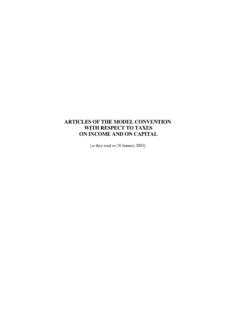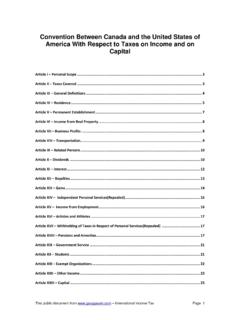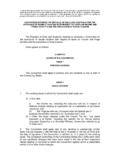Transcription of ARTICLES OF THE OECD MODEL TAX CONVENTION ON …
1 ARTICLES OF THE OECD MODEL TAX CONVENTION . ON income AND capital . [as they read on 22 July 2010]. SUMMARY OF THE CONVENTION . Title and Preamble Chapter I. SCOPE OF THE CONVENTION . Article 1 Persons covered Article 2 Taxes covered Chapter II. DEFINITIONS. Article 3 General definitions Article 4 Resident Article 5 Permanent establishment Chapter III. TAXATION OF income . Article 6 income from immovable property Article 7 Business profits Article 8 Shipping, inland waterways transport and air transport Article 9 Associated enterprises Article 10 Dividends Article 11 Interest Article 12 Royalties Article 13 capital gains Article 14 [Deleted]. Article 15 income from employment Article 16 Directors' fees Article 17 Artistes and sportsmen Article 18 Pensions Article 19 Government service Article 20 Students Article 21 Other income Chapter IV.
2 TAXATION OF capital . Article 22 capital Chapter V. METHODS FOR ELIMINATION OF DOUBLE TAXATION. Article 23 A Exemption method Article 23 B Credit method Chapter VI. SPECIAL PROVISIONS. Article 24 Non-discrimination Article 25 Mutual agreement procedure Article 26 Exchange of information Article 27 Assistance in the collection of taxes Article 28 Members of diplomatic missions and consular posts Article 29 Territorial extension Chapter VII. FINAL PROVISIONS. Article 30 Entry into force Article 31 Termination TITLE OF THE CONVENTION . CONVENTION between (State A) and (State B). with respect to taxes on income and on capital1. PREAMBLE TO THE CONVENTION2.
3 1 States wishing to do so may follow the widespread practice of including in the title a reference to either the avoidance of double taxation or to both the avoidance of double taxation and the prevention of fiscal evasion. 2 The Preamble of the CONVENTION shall be drafted in accordance with the constitutional procedure of both Contracting States. Chapter I. SCOPE OF THE CONVENTION . ARTICLE 1. PERSONS COVERED. This CONVENTION shall apply to persons who are residents of one or both of the Contracting States. ARTICLE 2. TAXES COVERED. 1. This CONVENTION shall apply to taxes on income and on capital imposed on behalf of a Contracting State or of its political subdivisions or local authorities, irrespective of the manner in which they are levied.
4 2. There shall be regarded as taxes on income and on capital all taxes imposed on total income , on total capital , or on elements of income or of capital , including taxes on gains from the alienation of movable or immovable property, taxes on the total amounts of wages or salaries paid by enterprises, as well as taxes on capital appreciation. 3. The existing taxes to which the CONVENTION shall apply are in particular: a) (in State A): .. b) (in State B): .. 4. The CONVENTION shall apply also to any identical or substantially similar taxes that are imposed after the date of signature of the CONVENTION in addition to, or in place of, the existing taxes.
5 The competent authorities of the Contracting States shall notify each other of any significant changes that have been made in their taxation laws. Chapter II. DEFINITIONS. ARTICLE 3. GENERAL DEFINITIONS. 1. For the purposes of this CONVENTION , unless the context otherwise requires: a) the term person includes an individual, a company and any other body of persons;. b) the term company means any body corporate or any entity that is treated as a body corporate for tax purposes;. c) the term enterprise applies to the carrying on of any business;. d) the terms enterprise of a Contracting State and enterprise of the other Contracting State mean respectively an enterprise carried on by a resident of a Contracting State and an enterprise carried on by a resident of the other Contracting State.
6 E) the term international traffic means any transport by a ship or aircraft operated by an enterprise that has its place of effective management in a Contracting State, except when the ship or aircraft is operated solely between places in the other Contracting State;. f) the term competent authority means: (i) (in State A): .. (ii) (in State B): .. g) the term national , in relation to a Contracting State, means: (i) any individual possessing the nationality or citizenship of that Contracting State; and (ii) any legal person, partnership or association deriving its status as such from the laws in force in that Contracting State;. h) the term business includes the performance of professional services and of other activities of an independent character.
7 2. As regards the application of the CONVENTION at any time by a Contracting State, any term not defined therein shall, unless the context otherwise requires, have the meaning that it has at that time under the law of that State for the purposes of the taxes to which the CONVENTION applies, any meaning under the applicable tax laws of that State prevailing over a meaning given to the term under other laws of that State. ARTICLE 4. RESIDENT. 1. For the purposes of this CONVENTION , the term resident of a Contracting State . means any person who, under the laws of that State, is liable to tax therein by reason of his domicile, residence, place of management or any other criterion of a similar nature, and also includes that State and any political subdivision or local authority thereof.
8 This term, however, does not include any person who is liable to tax in that State in respect only of income from sources in that State or capital situated therein. 2. Where by reason of the provisions of paragraph 1 an individual is a resident of both Contracting States, then his status shall be determined as follows: a) he shall be deemed to be a resident only of the State in which he has a permanent home available to him; if he has a permanent home available to him in both States, he shall be deemed to be a resident only of the State with which his personal and economic relations are closer (centre of vital interests);. b) if the State in which he has his centre of vital interests cannot be determined, or if he has not a permanent home available to him in either State, he shall be deemed to be a resident only of the State in which he has an habitual abode.
9 C) if he has an habitual abode in both States or in neither of them, he shall be deemed to be a resident only of the State of which he is a national;. d) if he is a national of both States or of neither of them, the competent authorities of the Contracting States shall settle the question by mutual agreement. 3. Where by reason of the provisions of paragraph 1 a person other than an individual is a resident of both Contracting States, then it shall be deemed to be a resident only of the State in which its place of effective management is situated. ARTICLE 5. PERMANENT ESTABLISHMENT. 1. For the purposes of this CONVENTION , the term permanent establishment means a fixed place of business through which the business of an enterprise is wholly or partly carried on.
10 2. The term permanent establishment includes especially: a) a place of management;. b) a branch;. c) an office;. d) a factory;. e) a workshop, and f) a mine, an oil or gas well, a quarry or any other place of extraction of natural resources. 3. A building site or construction or installation project constitutes a permanent establishment only if it lasts more than twelve months. 4. Notwithstanding the preceding provisions of this Article, the term permanent establishment shall be deemed not to include: a) the use of facilities solely for the purpose of storage, display or delivery of goods or merchandise belonging to the enterprise;. b) the maintenance of a stock of goods or merchandise belonging to the enterprise solely for the purpose of storage, display or delivery.

















